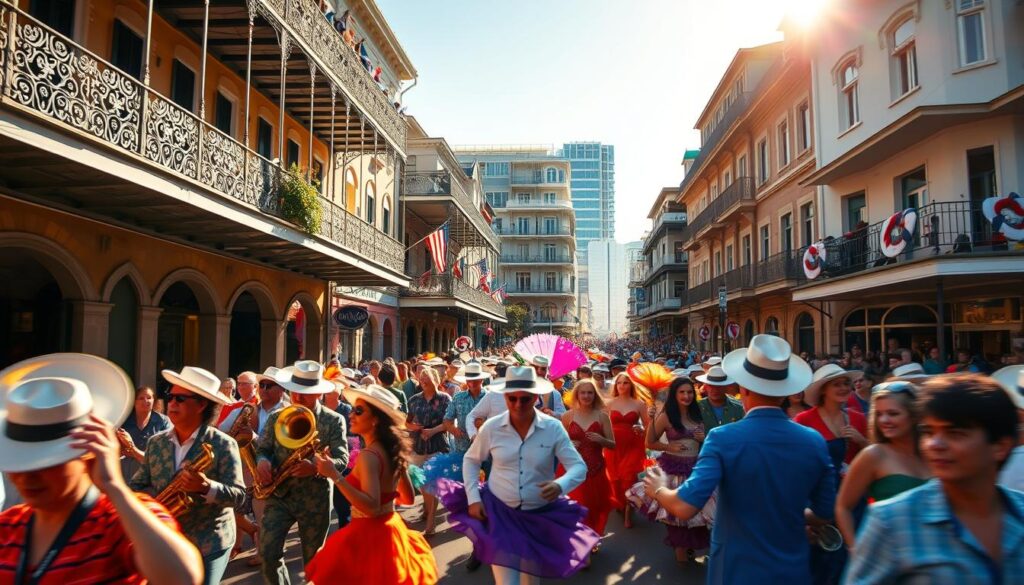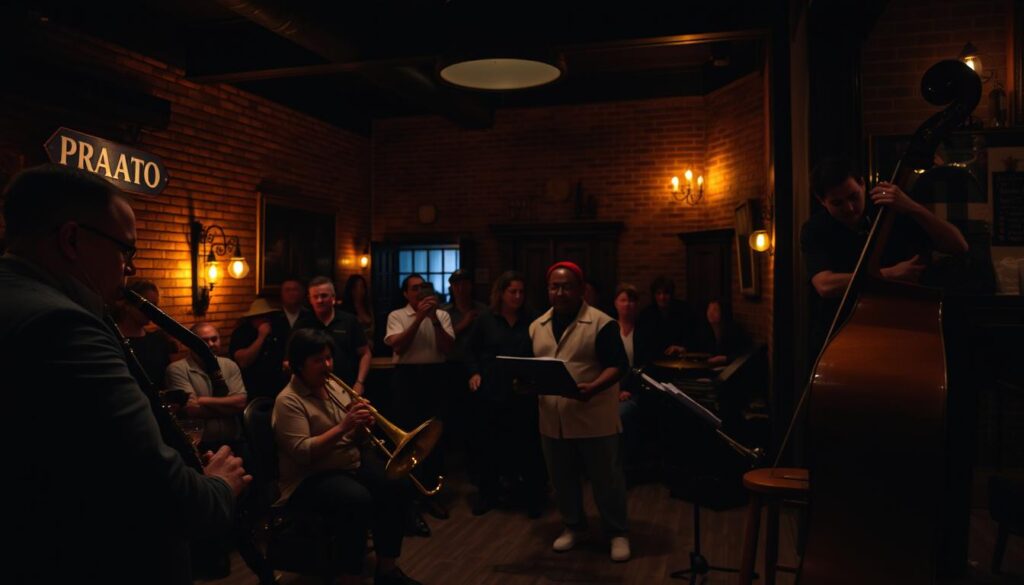The City of New Orleans operates one of several international music venues at which performers deliver live music for 360 nights annually. The historic Preservation Hall maintains its position at the center of the French Quarter where people celebrate the cultural heritage of the city.
The historical building was first used as an art gallery before it established itself as a traditional music sanctuary. The venue hosts acoustic concerts with a limited number of seats that have lured people worldwide to hear the music from a bygone musical era.
The energy of nearby Bourbon Street complements the venue due to its traditional parades. The charming environment created by Preservation Hall and Auditorium Square celebrates jazz’s original origins in an authentic manner.
Key Takeaways
- New Orleans serves as the origin of jazz music while maintaining a prosperous cultural history.
- Preservation Hall hosts live music nearly every night of the year.
- Visitors must experience Presention Hall because it stands in the French Quarter and presents music shows nearly all day long.
- The establishment moved from its initial role as an art gallery before developing into one of the most famous music venues.
- Bourbon Street activities enhance the musical atmosphere across the area.
The Origins of New Orleans Jazz Music Emerged at Preservation Hall
Larry Borenstein began his art gallery venture that later evolved into a musical refuge for music enthusiasts. Larry Borenstein opened impromptu jam sessions at his Associated Artists Gallery throughout the early 1960s. Musical events organized by Borenstein gathered accomplished musicians to preserve traditional jazz music.
The innovative approach of Borenstein transformed his exhibition space into an entertaining music venue. George Lewis and Sweet Emma Barrett joined frequent performer rosters at the gallery where they played their soulful music. Through these musical gatherings the fading live music scene experienced a revival which brought together both supporters and performers under one collective community.
Larry Borenstein’s Vision and Early Gallery Jam Sessions
The essence of Borenstein’s dream contained only basic yet important elements. He intended to create a stage where musicians in his community could display their musical talents. The gallery offered a cozy atmosphere which enabled musicians to perform genuine performances while bypassing contemporary musical fads. The bar kept traditional jazz authentic when rock’n’ roll and pianistic bebop music were becoming mainstream.
The Jaffes’ Influence on a Growing Jazz Legacy
During 1961 Allan and Sandra Jaffe acquired the establishment to make it Preservation Hall. Their dedication for jazz music preserved its existence throughout that era. The Jaffes implemented their commitment to live music at the venue which developed into a musical legacy still inspiring both performers and audience members around the globe. The Jaffes’ persistent dedication made Preservation Hall become a permanent part of the New Orleans cultural heritage.
The place known as Preservation Hall demonstrates how traditional jazz continues to maintain its enduring significance. The historical connection of Preservation Hall with New Orleans reminds us about cultural identity protection through musical traditions.
Cultural Impact and the Legacy of Bourbon Street
For many years Bourbon Street has functioned as the central musical element of New Orleans culture. Throughout the years the street festivals and parade events on Bourbon Street have defined the city’s cultural heritage. The events extend past entertainment value by presenting an evolving display of street music through live performances.
Bourbon Street Parades and the Evolution of Street Music
The town’s rich heritage continues to live through annual street parades celebrated on Bourbon Street. These events unite local jazz bands with marching ensembles which creates rhythmic sonorities that combine musical patterns. Musicians use the parades to establish connections with their audience through music performance thus preserving traditional music traditions.
Through the years the parades adapted by inducting fresh styles yet maintaining authenticity. The street parade’s energetic atmosphere has encouraged numerous artists to create new works which together sustain New Orleans’ musical heritage.
| Key Figures | Contributions |
|---|---|
| Larry Borenstein | Initiated jam sessions, transformed the gallery into a music venue |
| Allan and Sandra Jaffe | Preserved traditional jazz, established Preservation Hall’s legacy |
| George Lewis | Legendary musician, regular performer at early sessions |
| Sweet Emma Barrett | Iconic performer, contributed to the venue’s vibrant atmosphere |
How Traditional New Orleans Jazz Stood the Test of Time
Traditional jazz manages to stay authentic in spite of cultural changes that have occurred during numerous decades. The dance performances at these parades showcase the unchanging quality of this musical genre. Traditional music in New Orleans endures because local bands merge classical musical practices with contemporary changes.
The time when musical performances occur together with their rhythmic structure and audience involvement make traditional New Orleans Jazz truly extraordinary. These components combine to generate an original encounter which finds appreciation from both city residents and guests. Bourbon Street continues to wield lasting impacts which keep the musical traditions of the city alive and strong.
The music heritage of New Orleans developed from Bourbon Street until Preservation Hall emerged as its bastion.
The original New Orleans jazz melodies continue to spread their influence throughout the world. Local gatherings in local venues evolved into a worldwide phenomenon that changed musical styles throughout the world. Traditional jazz continues to thrive because of the timeless historical places that saved its roots through time.
Iconic Venues and Timeless Traditions
The essential role of Preservation Hall consists of preserving the jazz spirit throughout time. With its small and cozy space Preservation Hall has hosted numerous remarkable artists while preserving authentic musical performances in the werehouse music tradition. The jazz scene of New Orleans relies on live music together with improvisation thanks to its central role at this music venue.
Traditional jazz elements maintain their core position throughout the musical experience because they include both the distinctive clarinet theme and the solo performances of the clarinetist. The established practices protect genuine musical authenticity as the music moves forward in time.

From Local Jam Sessions to Global Influence
Jazz transformed from its original status as local jams to reach an international level of popularity through its remarkable evolution. When music started gathering in New Orleans this began shaping an upcoming genre that eventually got audiences from all corners of the planet. Preservation Hall established itself as an international launchpad by sending the one-of-a-kind orleans jazz musical traditions across the globe.
Since gaining worldwide recognition the genre adjusted to contemporary musical elements but kept its everlasting impact. Through endless adaptations of musical rhythms musicians connect traditional jazz with current musical expressions so the genre stays vital for upcoming artists.
Preservation Hall’s Role in Jazz Education and Cultural Preservation
The heart of New Orleans jazz education has developed into Preservation Hall’s fundamental mission to train upcoming musicians. The establishment of its foundation allows the organization to focus on maintaining traditional music heritage and cultivating artistic skills in upcoming musicians. Preservation Hall’s dedication to education allows the spiritual sounds of its jazz performances to withstand the test of time.
Educational Initiatives and the Preservation Hall Foundation
Through the foundation the Preservation Hall established an official structure for its educational purpose. The organization runs three main programs through their educational curriculum which features private instruction and collective workshops and outreach activities for the local community. The programs established these educational initiatives because their mission centers on developing student musicians who understand traditional music while becoming future guardians of this musical style.
The education programs at these facilities exist thanks to both master practitioners and respected artists. The instructors lead real-time educational sessions which unite traditional methods with present-day innovative approaches. Through direct interaction students and professional musicians equally acquire practical skills for their education in a genuine performance environment.
The lesson plans follow a systematic structure that addresses all academic abilities. The foundation provides personalized educational supports which begin with beginners and advance to experienced ensemble members. The workshops teach musicians to master three essential elements of preservation hall jazz which include improvisation and rhythm combined with distinct storytelling strategies.
The foundation devotes substantial effort to reach out to community members. Through educational programs the foundation takes its musical offerings into music classes and residential communities. The foundation shows the significance of cultural conservation by using public concert activities along with interactive musical events.
The organization developed digital resources accessible through the internet to educate people across the world. The tools give users access to tutorials combined with historical information as well as performance advice. The foundation creates accessible programs of education to maintain the lively and meaningful nature of this musical art form for future generations.
Preservation Hall executes ongoing educational programs that pass its musical heritage to emerging generations. The teaching and preservation initiatives at the institution guarantee the enduring legacy of the soulful preservation hall jazz performances into the future.




